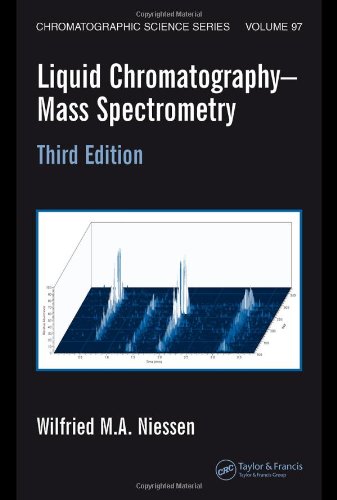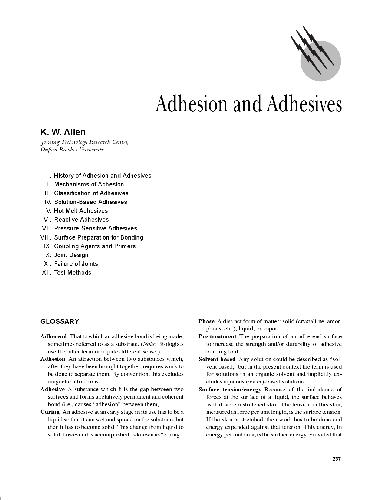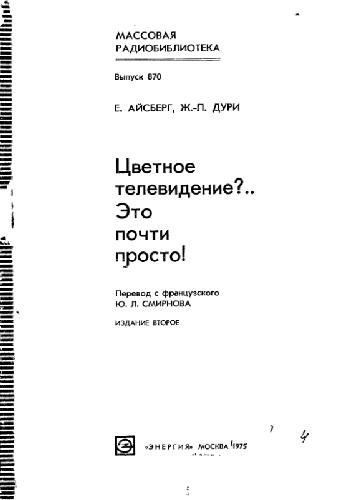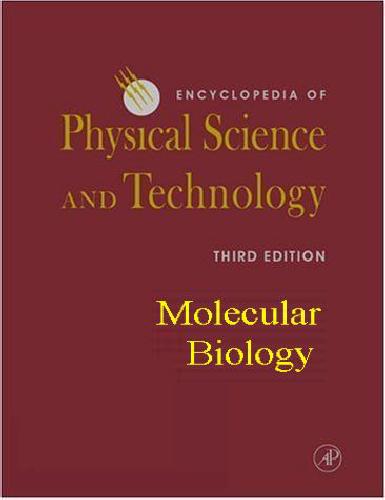Wilfried M.A. Niessen0824740823, 9780824740825
Table of contents :
Liquid Chromatography-Mass Spectrometry, Third Edition……Page 1
PREFACE TO THE THIRD EDITION……Page 7
PREFACE TO THE SECOND EDITION……Page 9
PREFACE TO THE FIRST EDITION……Page 11
CONTENTS……Page 13
ABBREVIATIONS……Page 14
Contents……Page 0
INTRODUCTION……Page 17
1. Introduction……Page 18
2. Instrumentation for liquid chromatography……Page 19
2.1 The column……Page 20
2.2 General detector characteristics……Page 21
2.3 Detectors for LC……Page 22
3.1 Intra- and intermolecular interactions……Page 24
3.3 Chromatography of ionic compounds……Page 26
4.2 Immunoaffinity chromatography……Page 27
4.3 Chiral separation……Page 28
4.5 Hydrophilic interaction chromatography……Page 29
5.1 Protein precipitation……Page 30
5.2 Liquid extraction and liquid- liquid extraction……Page 31
5.3 Solid- phase extraction……Page 32
5.5 Turbulent- flow chromatography……Page 34
6. References……Page 36
2. Analyte ionization……Page 38
2.2 Chemical ionization……Page 39
2.4 Energy- sudden or desorption ionization……Page 40
2.5 Nebulization ionization……Page 41
3. Information from mass spectrometry……Page 42
3.1 m/z Axis calibration……Page 44
3.2 Full- spectrum analysis and selected- ion monitoring……Page 46
4.1 Linear quadrupole MS and MS – MS instruments……Page 47
Tandem mass spectrometry……Page 48
Triple-quadrupole instrument for MS•MS……Page 49
4.2 Quadrupole ion trap MS and MS – MSn instruments……Page 50
MS•MS and MS•MSn in an ion trap……Page 51
Developments in ion-trap MS and MS•MSn……Page 53
4.3 Time- of- flight instruments……Page 54
4.5 Ion- trap – time- of- flight hybrid instruments……Page 56
4.6 Fourier- transform ion- cyclotron resonance instruments……Page 57
MS•MSn in an FT-ICR-MS instrument……Page 58
4.7 Sector and related hybrid instruments……Page 59
5. References……Page 60
TECHNOLOGY……Page 66
1. Introduction……Page 67
Off- line or on- line LC – MS……Page 69
2.1 The start……Page 70
2.2 Exploration of other strategies……Page 73
2.3 The breakthrough: commercial LC – MS interfaces……Page 76
3. Strategies in LC – MS interfacing……Page 77
3.1 Introduction of 1 ml/ min of an aqueous solvent……Page 78
3.2 Analyte enrichment in interfacing……Page 79
3.3 Solvent- based ionization strategies……Page 80
4. Conclusion……Page 81
5. References……Page 82
1. Introduction……Page 87
2. Capillary inlet……Page 88
3. Pneumatic nebulizer interfaces……Page 89
4. Moving- belt interface……Page 91
5. Direct liquid introduction……Page 93
6. Continuous- flow fast- atom bombardment……Page 95
7. Thermospray interface……Page 98
Instrumentation……Page 99
Analyte ionization……Page 100
Operation and optimization……Page 101
Selected applications……Page 102
Environmental applications……Page 103
Pharmaceutical applications……Page 104
Biochemical applications……Page 105
8. Particle- beam interface……Page 106
Instrumentation……Page 108
Operation and optimization……Page 109
Environmental applications……Page 110
Perspectives……Page 111
9. References……Page 112
1. Introduction……Page 118
2. Vacuum systems for mass spectrometry……Page 119
3.1 Fenn electrospray molecular- beam source……Page 121
3.2 Bruins- Sciex ionspray source……Page 122
3.3 Smith electrospray CE – MS source……Page 123
3.5 Hewlett- Packard orthogonal- sprayer source……Page 124
4. Commercial atmospheric- pressure ion sources……Page 125
4.1 Sample introduction devices……Page 126
4.2 Application of heat in the API source……Page 128
4.3 Ion- sampling apertures……Page 129
4.4 Transition- region fragmentation: In- source CID……Page 130
4.5 Ion optical devices……Page 131
5.1 History……Page 133
5.3 Multichannel electrospray inlets……Page 134
5.5 Nano- electrospray needles……Page 136
5.6 Microfabricated microfluidic and chip- based electrospray devices……Page 137
6.2 Nebulizers for APCI……Page 138
7.3 Atmospheric- pressure photoionization……Page 139
8.1 Quadrupole ion- trap instruments……Page 140
8.2 Time- of- flight instruments……Page 141
FT- ICR- MS with an external electrospray ion source……Page 142
8.4 Magnetic sector instruments……Page 143
Continuous- flow MALDI for LC – MS……Page 144
Atmospheric- pressure laser ionization……Page 145
10. References……Page 146
1. Introduction……Page 154
2.2 Electrohydrodynamic ionization……Page 155
2.5 Soft desolvation or charge residue model……Page 156
3.1 Overview……Page 157
3.2 Electrospray nebulization……Page 160
3.3 Electrochemical processes……Page 161
3.4 Analyte concentration and properties……Page 162
3.5 Wrong- way- around electrospray……Page 164
4.1 Ionization by a corona discharge……Page 166
Positive- ion mode……Page 167
Negative- ion mode……Page 168
4.3 Electron- capture negative ionization APCI……Page 169
5. Atmospheric- pressure photoionization……Page 170
6.1 Hardware issues……Page 171
6.2 Flow- rate……Page 172
Solvent selection……Page 173
Buffers……Page 175
Ion- pairing agents……Page 177
Other additives……Page 178
Solving mobile- phase incompatibilities……Page 179
7. Matrix effects in LC – MS……Page 180
7.1 Remove matrix constituents……Page 181
7.2 Eliminate effects on accuracy and/ or precision……Page 182
8. References……Page 183
APPLICATIONS: SMALL MOLECULES……Page 190
1. Introduction……Page 191
2.1 Carbamates……Page 192
2.2 Organophosphorous pesticides……Page 194
2.3 Triazines……Page 196
2.4 Phenylureas……Page 197
2.5 Halogenated phenoxy acids……Page 198
2.6 Sulfonylureas……Page 199
2.7 Quaternary ammonium herbicides……Page 200
2.8 Miscellaneous pesticide classes……Page 202
3.1 General considerations……Page 204
Off- line solid- phase extraction……Page 205
On- line solid- phase extraction……Page 206
4.1 Quaternary ammonium herbicides as target compounds……Page 207
4.2 Confirmation of identity……Page 208
5.1 Multiresidue target analysis……Page 210
5.2 General contaminant screening……Page 211
6.1 Chlorophenols and nitrophenols……Page 212
6.3 Ionic chloracetanilide metabolites……Page 213
7. Pesticide residues in fruit and vegetables……Page 214
9. References……Page 217
2. Natural organic matter……Page 227
3. Endocrine disrupting compounds……Page 229
3.1 Steroids……Page 230
4.1 Anionic surfactants……Page 231
4.2 Nonionic surfactants……Page 234
5. Pharmaceuticals……Page 236
6. Haloacetic acids……Page 237
8. References……Page 239
1. Introduction……Page 244
2. Open- access LC – MS for synthetic chemists……Page 246
3. Characterization of combinatorial libraries……Page 247
4. LC – MS in high- throughput bioactivity screening……Page 251
5. Screening and identification of drug impurities……Page 255
5.1 General issues in impurity profiling……Page 256
5.2 Identification of reaction byproducts……Page 259
5.4 MS- directed fractionation in preparative LC……Page 260
6. References……Page 261
1. Introduction……Page 267
2. General considerations……Page 268
2.1 Phase- I metabolism……Page 269
2.3 General approach in metabolite identification……Page 270
3.1 Prediction of metabolites……Page 271
3.3 Metabolite identification from mass shifts……Page 272
3.4 Importance of LC separation……Page 276
4.2 Precursor- ion and neutral- loss analysis modes……Page 278
4.3 MS – MS instrumentation: Quadrupole – time- of- flight hybrid……Page 280
4.4 Data- dependent acquisition……Page 281
4.5 MS – MS instrumentation: Quadrupole – linear- ion- trap hybrid……Page 282
4.7 Combined LC – MS and LC – NMR……Page 283
4.8 Hydrogen/ deuterium exchange……Page 284
4.9 Stable- isotope labelling and isotope cluster technique……Page 285
5.1 LC – MS( – MS) of conjugated metabolites……Page 286
5.2 Neutral- loss and precursor- ion analysis……Page 287
6. Additional topics in metabolism studies……Page 288
6.1 Metabolic stability screening……Page 289
6.3 Drug- drug interaction via cytochrome P450 inhibition screening……Page 290
7. References……Page 291
1. Introduction……Page 298
2. General considerations……Page 299
3. Method development……Page 300
3.2 Chromatography……Page 301
3.3 Choice between ESI and APCI……Page 302
3.4 Internal standard……Page 303
3.5 Mass spectrometry……Page 304
4.1 Reserpine……Page 306
4.2 Risperidone……Page 307
4.3 Cholesterol- reducing drugs……Page 309
4.4 Methylphenidate……Page 311
4.5 Loratadine……Page 313
5.1 Understanding matrix effects……Page 315
5.2 Quantitative description of matrix effects……Page 319
5.4 Other issues related to matrix effects……Page 320
6. Sample pretreatment……Page 321
6.2 Protein precipitation……Page 322
6.4 Solid- phase extraction……Page 323
6.5 Alternative SPE- related procedures……Page 325
7.1 Do we need LC separation?……Page 326
7.4 Chiral separations……Page 327
8. Increasing sample throughput……Page 328
9. References……Page 330
1. Introduction……Page 340
2.1 Immunosuppressive drugs……Page 341
2.2 TDM of HIV protease inhibitors……Page 346
2.3 Nucleoside reverse transcriptase inhibitors……Page 348
3. Neonatal screening for inherited metabolic disorders……Page 350
3.1 Acylcarnitines……Page 351
4.1 Amphetamines……Page 354
4.2 Lysergic acid diethylamide ( LSD)……Page 355
4.3 Morphine and its glucuronides……Page 356
4.5 Multiresidue methods……Page 357
5. Systematic toxicological analysis……Page 358
6. References……Page 359
1. Introduction……Page 367
2.1 History……Page 368
2.2 Electrospray and APCI of steroids……Page 369
2.3 Steroid derivatization……Page 372
2.4 ESI and APCI of steroid conjugates……Page 373
2.5 Fragmentation of steroids in MS – MS……Page 374
3.1 Racing horses……Page 376
3.2 Human athletes……Page 378
4.1 Breast and prostate cancer……Page 379
4.2 Neurosteroids……Page 381
6. References……Page 382
1. Introduction……Page 388
2.1 Sulfonamides……Page 390
2.2 ( Fluoro) quinolones……Page 391
2.4 Betalactam antibiotics……Page 392
2.5 Aminoglycosides……Page 393
2.7 Chloramphenicol……Page 394
3.1 Sulfonamides……Page 395
3.3 Tetracyclines……Page 397
3.4 Betalactam antibiotics……Page 399
3.5 Aminoglycosides……Page 400
3.7 Chloramphenicol……Page 401
4. Residue analysis of steroids……Page 402
5. Heterocyclic aromatic amines……Page 404
6. Toxins……Page 405
6.1 Trichothecene mycotoxins……Page 406
6.2 Other mycotoxins……Page 407
6.3 Marine biotoxins……Page 408
7. References……Page 411
1. Introduction……Page 420
2.1 General structure……Page 421
2.3 Information in mass spectra……Page 423
2.4 Aglycone fragmentation in positive- ion MS – MS……Page 424
2.5 Aglycone fragmentation in negative- ion MS – MS……Page 426
2.6 Fragmentation of flavonoid glycosides……Page 428
3. LC – MS analysis of flavonoids in plant material……Page 430
3.1 Flavonoids in plant materials……Page 431
4. LC – MS analysis of flavonoids in food products……Page 432
4.1 Flavonoid profiling……Page 433
4.2 Flavonoids and isoflavones in soybean products……Page 434
4.3 Flavonoids and catechins in tea……Page 435
5.1 Flavonoids in human body fluids……Page 436
6. Anthocyanidins and related compounds……Page 437
7. Related plant phenolic compounds……Page 438
8. References……Page 439
APPLICATIONS: BIOMOLECULES……Page 445
1. Introduction……Page 446
2.2 Molecular- weight determination……Page 448
2.3 Ionization mechanism and charge- state distribution……Page 450
3.1 Direct infusion experiments……Page 452
3.2 Reversed- phase LC – MS of proteins……Page 454
3.4 Selected applications……Page 456
4. Characterization of proteins……Page 458
5. Protein conformation……Page 460
6. Conclusions and perspectives……Page 461
7. References……Page 462
1. Introduction……Page 467
2. Nanoelectrospray……Page 468
3. Proteins from gel electrophoresis……Page 469
4.2 Desalting and solvent switching……Page 470
4.4 Enzymatic digestion……Page 471
5.2 Nano- LC……Page 473
5.4 Multidimensional LC……Page 475
5.5 Microfluidic chips……Page 477
5.6 Capillary electrophoresis – MS……Page 478
6.1 Fragmentation of peptides……Page 479
6.2 Database searching……Page 481
6.3 De novo sequencing……Page 482
7.2 Data- dependent acquisition……Page 483
7.3 Fourier- transform ion- cyclotron resonance MS……Page 485
9. References……Page 487
1. Introduction……Page 497
2. Proteomics, a concise overview……Page 498
2.1 Peptide mass fingerprinting……Page 499
2.2 Peptide sequence analysis……Page 500
3. Mining the proteome……Page 501
3.2 Shotgun protein identification: on- line LC × LC – MS……Page 503
3.4 Shotgun protein identification: FT- ICR- MS……Page 506
3.5 Top- down protein identification……Page 507
3.6 Identification of membrane proteins……Page 509
4.1 Labelling of proteins: ICAT……Page 510
4.2 Labelling of proteins or peptides: Alternative methods……Page 512
4.3 Isolation of labelled peptides……Page 513
4.4 Targeted quantitative analysis……Page 514
5. Protein- protein interactions……Page 515
6. Biomarker discovery……Page 516
7. References……Page 517
1. Introduction……Page 526
2. General considerations……Page 527
3. Protein phosphorylation……Page 528
3.1 MS screening for phosphopeptides……Page 529
3.2 Liquid- phase selection of phosphopeptides……Page 533
3.3 Derivatization and labelling of phosphopeptides……Page 534
3.4 Selected applications……Page 535
4. Protein glycosylation……Page 536
4.1 Glycoprotein detection using diagnostic oxonium ions……Page 537
4.2 Glycoprotein characterization……Page 539
5. References……Page 541
1. Introduction……Page 548
2 Structure of oligosaccharides……Page 549
3. Mass spectrometry of oligosaccharides……Page 550
3.1 Electrospray ionization of oligosaccharides……Page 551
3.2 MS – MS of oligosaccharides……Page 552
3.3 Multistage MS – MS using ion- trap instruments……Page 554
3.5 Derivatization of oligosaccharides……Page 555
4.1 High- performance anion- exchange chromatography……Page 558
4.2 Reversed- phase chromatography……Page 559
5. Conclusion and perspectives……Page 561
6. References……Page 562
2. Fatty acid analysis……Page 567
3.1 Chromatographic separation……Page 568
3.2 Characterization by MS – MS……Page 570
3.4 Selected applications……Page 571
4. Metabolites of arachidonic acid……Page 572
4.1 Hydroxyeicosatetraenoic acids……Page 573
4.2 Prostaglandins……Page 574
5. Phospholipids……Page 575
5.1 Sphingomyelins……Page 576
5.2 Chromatography of glycerophospholipids……Page 577
5.3 Characterization by MS – MS of glycerophospholipids……Page 578
6. References……Page 579
1. Introduction……Page 585
1.2 Oligonucleotides……Page 586
2.2 ESI- MS of nucleosides and nucleotides……Page 587
2.3 LC analysis of oligonucleotides……Page 588
2.4 Desalting sample pretreatment strategies……Page 589
2.5 ESI- MS of oligonucleotides……Page 590
2.6 Fragmentation by MS – MS……Page 591
3.1 Quality control of synthetic oligonucleotides……Page 592
3.4 Single nucleotide polymorphism……Page 593
4.1 Urinary analysis of oxidized nucleobases……Page 595
5. LC – MS analysis of DNA adducts……Page 596
6. References……Page 597







Reviews
There are no reviews yet.